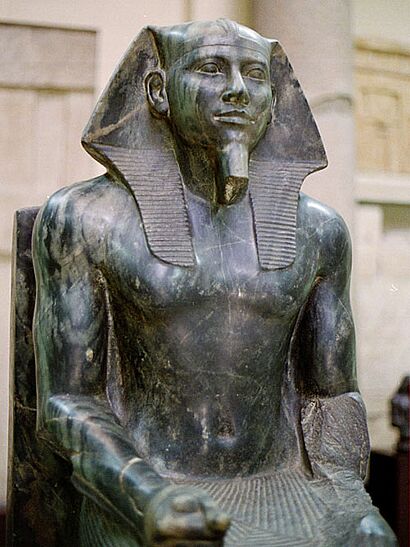Khafre Enthroned facts for kids
Quick facts for kids Khafre Enthroned |
|
|---|---|
 |
|
| Year | c. 2570 BC |
| Medium | Anorthosite gneiss |
| Subject | Khafre |
| Dimensions | 168 cm (66 in) |
| Location | Egyptian Museum in Cairo |
The Khafre Enthroned statue is an amazing ancient Egyptian sculpture. It shows Pharaoh Khafre sitting on his royal throne. Khafre ruled Egypt during the Fourth Dynasty, around 2570 BCE. Today, you can see this important statue in the Egyptian Museum in Cairo.
This statue is made from a very hard, dark stone called anorthosite gneiss. This special stone was brought over 400 miles down the Nile River from royal quarries. Using such a rare and tough stone showed how important and powerful Pharaoh Khafre was. The statue was made for Khafre's valley temple, which was near the Great Sphinx. This temple was part of a large area called a necropolis, or "city of the dead," used for funeral ceremonies.
Contents
Why Was This Statue Made?
A Home for the Pharaoh's Spirit
In ancient Egypt, people believed in a life force called the ka. This was like a person's spirit or other self. After someone died, their ka would leave their body and go into the afterlife. However, the ka still needed a place to rest. That's where statues like Khafre Enthroned came in!
Egyptians practiced mummification, a long process that took 70 days. This was to make sure the pharaoh's body would last forever. But if the pharaoh's mummy ever got damaged, a special ka statue was made. This statue would be a backup home for the pharaoh's spirit. It helped make sure the pharaoh's identity and life force would last forever, even after death.
What Does the Statue Look Like?
Pharaoh Khafre's Royal Appearance
Khafre sits very straight and still on his throne, looking far away. He wears a special linen headdress called a nemes. This headdress covers most of his forehead and folds over his wide shoulders. On the front of the headdress, you can see the uraeus, which is a cobra symbol. This cobra shows he is a king. He also has a royal false beard attached to his chin.
Khafre wears a kilt around his waist. His upper body is shown as strong and perfect, with clear muscles. Egyptian artists didn't try to show a pharaoh's exact face. Instead, they wanted to show that the king was like a god.
Symbols of Power and Unity
The throne Khafre sits on is very strong. It has two stylized lion bodies forming its base. Between the legs of the throne, you can see lotus plants and papyrus plants. Lotus plants stood for Upper Egypt, and papyrus plants stood for Lower Egypt. These plants together show that Upper and Lower Egypt were united. This unity happened after the Egyptian predynastic period.
Behind Khafre's head, the god Horus is shown as a falcon. Horus spreads his wings to protect the pharaoh. This is another symbol of a united Egypt. You can't see the falcon from the front, but it's a powerful detail.
Khafre's feet rest on a flat platform. On this platform, there are nine archery bows carved into the stone. These bows represent the nine bows, which were symbols of Egypt's enemies. This carving shows that the king and his kingdom were strong and controlled all foreign and local enemy tribes.
A Timeless and Strong Ruler
The statue of Khafre is very symmetrical, meaning it's the same on both sides. This shows the pharaoh's order and control. Khafre looks perfectly still, with no movement. This stillness was meant to show that he was timeless and that his power would last forever, even in the afterlife.
The statue is very solid and block-like, with few parts sticking out. Khafre's body is connected to the throne, making it one strong structure. This was done so the statue would last for eternity. His arms rest on his thighs, and he faces forward. The only difference between the two sides is Khafre's clenched right fist. This strong, block-like look was meant to keep Khafre's ka safe forever. It shows that the pharaoh will always exist, both on Earth and in the afterlife.
How Was Khafre Enthroned Made?
Sculpting from a Stone Block
To create this amazing statue, the sculptor used a method called the subtractive method. This means they started with a large, cube-shaped block of diorite stone.
First, the sculptor drew the front, back, and side views of Khafre onto the four sides of the stone block. After these plans were drawn, the sculptor began to chisel away the extra stone from all four sides. They kept chiseling until the drawn plans met perfectly at right angles.
The last step was to carve the smaller details of Khafre's body and face. The sculptor also carved the falcon god Horus and the other designs on the throne. This subtractive method helped create the block-like look that was common for Egyptian sculptures during this time. After the carving was done, the surface was smoothed by rubbing or grinding it. The finished statue stands about five feet six inches tall.

